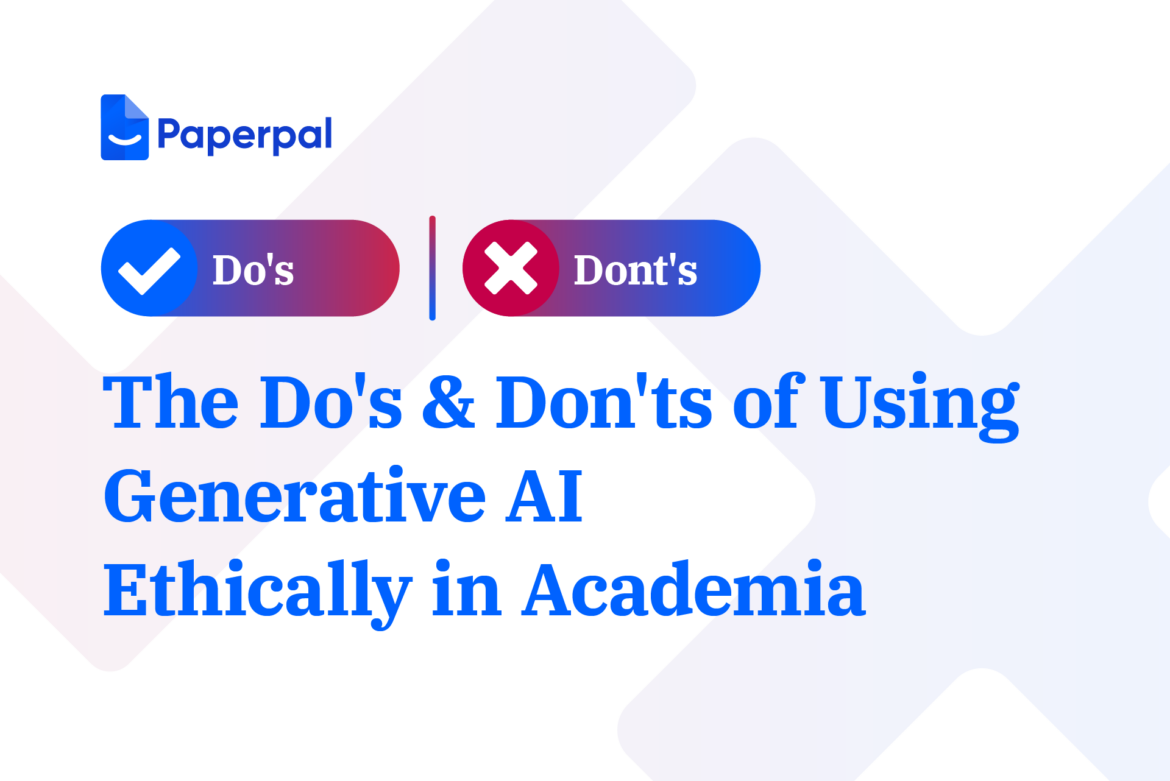Generative AI has ushered in a new era of possibilities, redefining the way we create content, analyze data, and unlock new insights. However, as academics delve into the efficiencies that these generative AI tools offer, it’s crucial to recognize their limitations and be aware of the ethical considerations around using these AI tools in scholarly publishing.
Ethical AI isn’t just a checkbox; it’s a mindset. The focus is no longer about what these AI tools can do; it’s about how we, as responsible academics, wield this power. Remember, there’s a fine line between relying too much on generative AI and using it to enhance and support your expertise. To help you walk the right path, Paperpal has put together a detailed list of dos and don’ts when using generative AI tools. This is meant to act as a roadmap with best practices to help you harness the power of AI ethically in your academic pursuits.
| Do’s | Don’ts |
|---|---|
| Using Generative AI Tools | |
| Act as the expert with generative AI as your assistant – not the other way around. | Don’t use AI as a replacement for your own expertise on critical-thinking tasks like research gap identification, hypothesis generation, data analysis, etc. |
| Do the research and lay the groundwork for AI to become more productive along the way, with summaries, ideas, information, etc. | Don’t blindly use AI outputs a shortcut to get readymade results without putting in the work. |
| Understand that the AI-assisted or -generated output may contain biased or factually incorrect details and will need a thorough review before use. | Don’t use generative AI tools without educating yourself on how it works, what it does best, and what it does not. |
| Journal/University Policies | |
| Familiarize yourself with university/journal policy on the use of AI tools and follow guidelines carefully on citing the tools and the purpose they were used for. | Don’t skip university or journal guidelines declaring the use of AI tools on the assumption that some types of uses are acceptable. |
| Use a reliable plagiarism detection software to identify text that may inadvertently be similar to published works, as a pre-emptive measure before submission. | Don’t use paraphrasers and plagiarism checkers to intentionally hide passing off others’ content as your own. |
| Always verify AI-assisted or -generated text, discarding the unnecessary bits, and refining the rest so it meaningfully fits your voice and your work. | Don’t submit AI-generated abstracts, essays, or any other content directly without thorough review; this is considered a form of plagiarism and cheating. |
| Literature Discovery & Reading | |
| Find articles related to your research area as a starting point and use AI tools to find more relevant articles to add to your library for deeper analysis at a later time. | Don’t blindly trust tools that add random citations into your text; review suggestions carefully. Only you know what relates properly to your research. |
| Use AI to summarize articles and speed up the process of extracting themes from a large set of articles and make literature review more efficient. | Don’t substitute a thorough critical literature review with AI-generated summaries or ChatPDF-type solutions, no matter how rushed for time you are. |
| Use AI to understand concepts and brainstorm ideas while reviewing literature to identify research gaps and validate your hypotheses. | Don’t rely completely on AI to come up with a research idea or hypothesis and then incorporate citations later as a shortcut. |
| AI in Academic Writing | |
| If your original writing gets a high AI-generated score, remember that AI detectors are notorious for false positives! Talk to your supervisor or journal editor and try to show evidence of your writing history. | Don’t forget to verify AI-generated or AI-assisted text for inaccuracies and refine the content to suit your content in your own voice. |
| Know that AI-generated or AI-assisted text may be flagged by plagiarism tools. Examine the flagged portions to check and add a citation if the source relates to your work. | Don’t try to evade detection by plagiarism checkers; be wary of any tools that claim to reduce the similarity score! |
| Academic writing is a challenge for both native and non-native English speakers. Use AI tools prudently to save time, communicate ideas well, and be more productive. | Don’t let any misgivings about these AI tools lead you lose out on the many advantages that generative AI has to offer for academic writing. |
The dos and don’ts shared here will serve as a compass, guiding you toward ethical AI use and decision-making in all your academic endeavors. At Paperpal, we are committed to fostering a community of academics that embraces AI responsibly. If you have any queries, comments, or feedback, please write to us at hello@paperpal.com; we’d love to hear from you. Finally, note that this is not an exhaustive list. As AI innovations continue in leaps and bounds, it is essential to stay aware of changing journal policies and guidelines for scholarly publishing. Here’s wishing you all the best!
Paperpal is a comprehensive AI writing toolkit that helps students and researchers achieve 2x the writing in half the time. It leverages 23+ years of STM experience and insights from millions of research articles to provide in-depth academic writing, language editing, and submission readiness support to help you write better, faster.
Get accurate academic translations, rewriting support, grammar checks, vocabulary suggestions, and generative AI assistance that delivers human precision at machine speed. Try for free or upgrade to Paperpal Prime to access premium features, including consistency, plagiarism, and 30+ submission readiness checks to help you succeed.
Experience the future of academic writing – Sign up to Paperpal and start writing for free!



